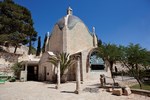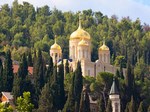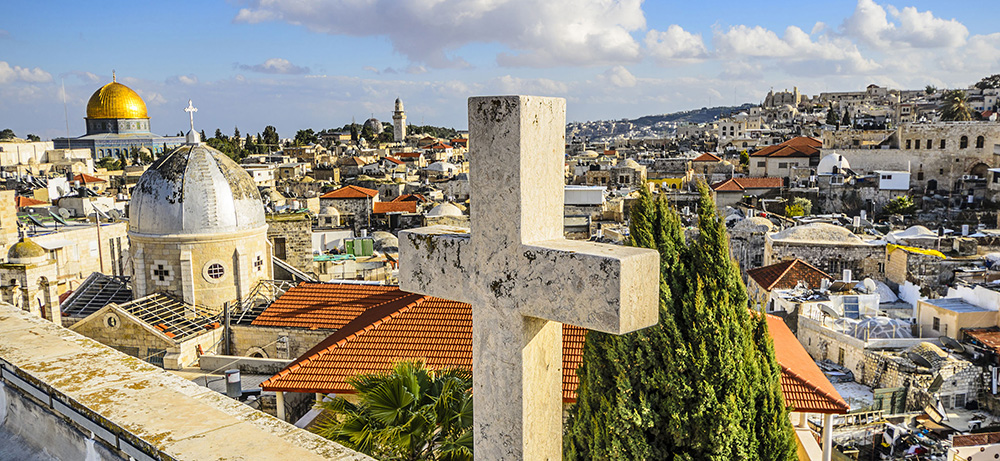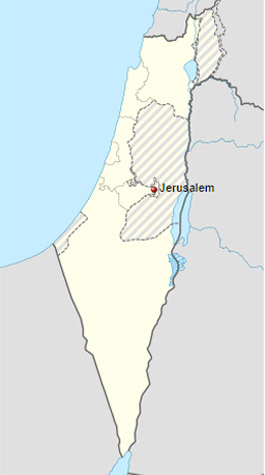Jerusalem
- Jerusalem is the “Holy City” where Christ was crucified, buried and rose, as told in the Bible. In the third century and under the reign of the Roman Empire Jerusalem became a Christian shrine. It is surrounded by a wall with seven gates. Jerusalem is very rich in its historical and religious sites.
Bethphage
 it’s on the slopes of the Mount of Olives and the starting point of the palm Sunday procession, associated with the last days of Jesus, where Jesus sent two of his disciples to Bethphage to fetch a young ass for him to ride when entering Jerusalem.
it’s on the slopes of the Mount of Olives and the starting point of the palm Sunday procession, associated with the last days of Jesus, where Jesus sent two of his disciples to Bethphage to fetch a young ass for him to ride when entering Jerusalem.
The Church of the Pater Noster
 This church was built in the 4th century by the Empress Helena, mother of Constantine; it’s the place where Jesus taught the Lord’s Prayer, now the Carmelite cloister is lined with glazed tiles bearing the text of the prayer in more than sixty languages, including braille.
This church was built in the 4th century by the Empress Helena, mother of Constantine; it’s the place where Jesus taught the Lord’s Prayer, now the Carmelite cloister is lined with glazed tiles bearing the text of the prayer in more than sixty languages, including braille.
Mount of Olives
 This mountain is first mentioned in the bible when King David, fleeing from Absalom. It holds a high importance for Christians because it’s where Jesus spent most of his time during his mission in Jerusalem. Pilgrims walk through this mount during the Palm Sunday procession.
This mountain is first mentioned in the bible when King David, fleeing from Absalom. It holds a high importance for Christians because it’s where Jesus spent most of his time during his mission in Jerusalem. Pilgrims walk through this mount during the Palm Sunday procession.
The Dome of Ascension
 It’s a small dome stands in the center of an octagonal courtyard, from this spot, Jesus ascended to heaven forty days after his resurrection.
It’s a small dome stands in the center of an octagonal courtyard, from this spot, Jesus ascended to heaven forty days after his resurrection.
The Coenaculum ( The last supper room)
 “The larger upper room furnished and prepared” where Jesus and his disciples ate the Passover feast, the last supper.
“The larger upper room furnished and prepared” where Jesus and his disciples ate the Passover feast, the last supper.
Dominis Flevit
 It’s the spot where Jesus wept over the fate of the city of Jerusalem. The present church was built over the ruins of an ancient church.
It’s the spot where Jesus wept over the fate of the city of Jerusalem. The present church was built over the ruins of an ancient church.
Gethsemane - The Church of all Nations
 Gethsemane lies on the lower slopes of the Mount of Olives, the name Gat-Shamna is an Aramaic term means Olive-press. It’s the place where Jesus came with his disciples to pray. It also includes The Church of all Nations. that was built by the Italian architect Barluzzi over the remains of two previous churches. Within the Church is the rock of Agony upon which Jesus prayed and sweated blood the night before his arrest.
Gethsemane lies on the lower slopes of the Mount of Olives, the name Gat-Shamna is an Aramaic term means Olive-press. It’s the place where Jesus came with his disciples to pray. It also includes The Church of all Nations. that was built by the Italian architect Barluzzi over the remains of two previous churches. Within the Church is the rock of Agony upon which Jesus prayed and sweated blood the night before his arrest.
The Church of the Tomb of Virgin Mary
 This place is where Mary was buried and then taken up to heaven. It’s a candle-lit cave, that was built by the crusaders, today it’s in the hands of the Armenians and Greek Orthodox churches.
This place is where Mary was buried and then taken up to heaven. It’s a candle-lit cave, that was built by the crusaders, today it’s in the hands of the Armenians and Greek Orthodox churches.
The Church of St. Peter in Gallicantu
 This church stands on the site of the Caiphas house, the high priest at the time of Jesus, where Peter denied his master.
This church stands on the site of the Caiphas house, the high priest at the time of Jesus, where Peter denied his master.
The Church of St. Anne
 This is one of the best examples of best-preserved churches that was built during the crusader period. It’s near St. Stephan Gate. When Saladin conquered Jerusalem he turned it into an Islamic school but after the Ottoman conquest. It was abandoned and now it’s a Greek seminary of the White Fathers.
This is one of the best examples of best-preserved churches that was built during the crusader period. It’s near St. Stephan Gate. When Saladin conquered Jerusalem he turned it into an Islamic school but after the Ottoman conquest. It was abandoned and now it’s a Greek seminary of the White Fathers.
Via Dolorosa (The Stations of the Cross)
 The Via Dolorosa is the way of sorrow and suffering in the old city of Jerusalem; it is the path that Jesus Christ walked through carrying his cross to be crucified from Antonia Fortress the Headquarter of the Roman garrison stationed in Jerusalem and the Church of Holy Sepulchre.
The Via Dolorosa is the way of sorrow and suffering in the old city of Jerusalem; it is the path that Jesus Christ walked through carrying his cross to be crucified from Antonia Fortress the Headquarter of the Roman garrison stationed in Jerusalem and the Church of Holy Sepulchre.
The Church of the Holy Sepulcher
 It’s considered one of the holiest places for Christians around the world After Empress Helena discovered the tomb of Jesus; it was built by the order of the Emperor Constantine the great following the council of Nicaea in 325 AD. At the time of Jesus, the tomb existed outside the walls of Jerusalem.
It’s considered one of the holiest places for Christians around the world After Empress Helena discovered the tomb of Jesus; it was built by the order of the Emperor Constantine the great following the council of Nicaea in 325 AD. At the time of Jesus, the tomb existed outside the walls of Jerusalem.
Bethany
 It’s an arab village lies to the eastern slope of Mount Olives called El Azariya, the ancient Bethany, where Jesus performed his miracle of raising Lazarus, the brother of Martha and Mary, from death.
It’s an arab village lies to the eastern slope of Mount Olives called El Azariya, the ancient Bethany, where Jesus performed his miracle of raising Lazarus, the brother of Martha and Mary, from death.
Ein Karem
 It’s a town where Zacharia and Elizabeth lived, it’s also known as the “City of Judah” associated with the life of John and Baptist. Many churches and convents were built in this city, one of them is the Church of St. John the Baptist that was built over the place where St. John was born.
It’s a town where Zacharia and Elizabeth lived, it’s also known as the “City of Judah” associated with the life of John and Baptist. Many churches and convents were built in this city, one of them is the Church of St. John the Baptist that was built over the place where St. John was born. - “And Mary arose in those days, and went into the hill country with haste into a city of Judah, and entered into the house of Zacharias and saluted Elizabeth” Luke 1:39-40
Abu Gosh
 Abu Gosh is a small village on the way from Jerusalem to Tel-Aviv. In this village there is a Benedictine monastery which belongs to the Olivetan Benedictine Stream. The original monastery was built in the 12th century and it has recently been renovated.
Abu Gosh is a small village on the way from Jerusalem to Tel-Aviv. In this village there is a Benedictine monastery which belongs to the Olivetan Benedictine Stream. The original monastery was built in the 12th century and it has recently been renovated.

 +972-599-446363
+972-599-446363
 The church of Emmaus is where Jesus met with Cleophas and Simon after his resurrection.
The church of Emmaus is where Jesus met with Cleophas and Simon after his resurrection. 
